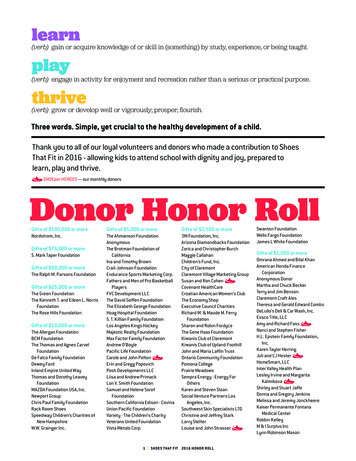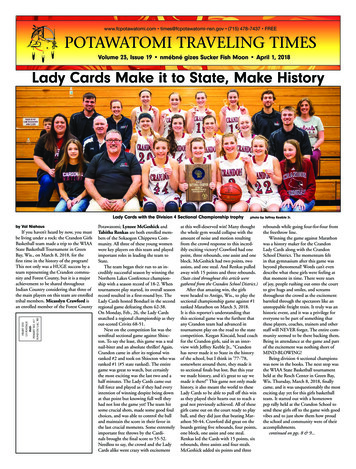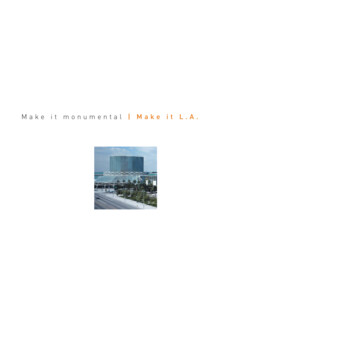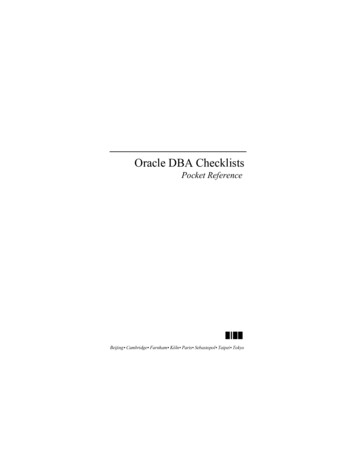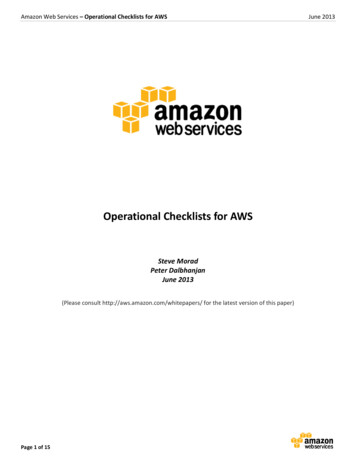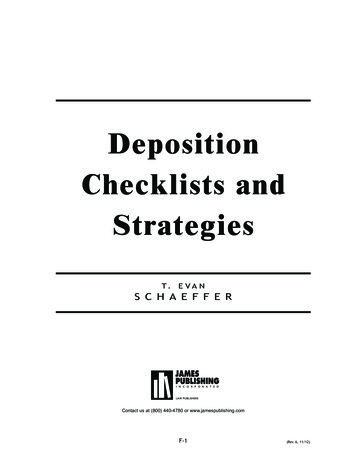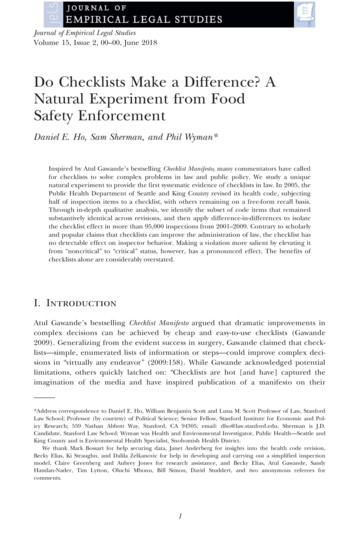
Transcription
Journal of Empirical Legal StudiesVolume 15, Issue 2, 00–00, June 2018Do Checklists Make a Difference? ANatural Experiment from FoodSafety EnforcementDaniel E. Ho, Sam Sherman, and Phil Wyman*Inspired by Atul Gawande’s bestselling Checklist Manifesto, many commentators have calledfor checklists to solve complex problems in law and public policy. We study a uniquenatural experiment to provide the first systematic evidence of checklists in law. In 2005, thePublic Health Department of Seattle and King County revised its health code, subjectinghalf of inspection items to a checklist, with others remaining on a free-form recall basis.Through in-depth qualitative analysis, we identify the subset of code items that remainedsubstantively identical across revisions, and then apply difference-in-differences to isolatethe checklist effect in more than 95,000 inspections from 2001--2009. Contrary to scholarlyand popular claims that checklists can improve the administration of law, the checklist hasno detectable effect on inspector behavior. Making a violation more salient by elevating itfrom “noncritical” to “critical” status, however, has a pronounced effect. The benefits ofchecklists alone are considerably overstated.I. IntroductionAtul Gawande’s bestselling Checklist Manifesto argued that dramatic improvements incomplex decisions can be achieved by cheap and easy-to-use checklists (Gawande2009). Generalizing from the evident success in surgery, Gawande claimed that checklists—simple, enumerated lists of information or steps—could improve complex decisions in “virtually any endeavor” (2009:158). While Gawande acknowledged potentiallimitations, others quickly latched on: “Checklists are hot [and have] captured theimagination of the media and have inspired publication of a manifesto on their*Address correspondence to Daniel E. Ho, William Benjamin Scott and Luna M. Scott Professor of Law, StanfordLaw School; Professor (by courtesy) of Political Science; Senior Fellow, Stanford Institute for Economic and Policy Research; 559 Nathan Abbott Way, Stanford, CA 94305; email: dho@law.stanford.edu. Sherman is J.D.Candidate, Stanford Law School; Wyman was Health and Environmental Investigator, Public Health—Seattle andKing County and is Environmental Health Specialist, Snohomish Health District.We thank Mark Bossart for help securing data, Janet Anderberg for insights into the health code revision,Becky Elias, Ki Straughn, and Dalila Zelkanovic for help in developing and carrying out a simplified inspectionmodel, Claire Greenberg and Aubrey Jones for research assistance, and Becky Elias, Atul Gawande, SandyHandan-Nader, Tim Lytton, Oluchi Mbonu, Bill Simon, David Studdert, and two anonymous referees forcomments.1
2Ho et al.power in managing complexity” (Davidoff 2010:206).1 Or as the Times put it, checklists are “a classic magic bullet” (Aaronovitch 2010).Fueled in part by Gawande’s manifesto, scholars have, in turn, advocated forgreater adoption of checklists in law and public policy. Richard Thaler and Cass Sunstein consider the checklist as part of choice architecture (Thaler et al. 2012:432). BillSimon (2012:394) urged “[p]rotocols of the sort that Gawande developed,” suggestingprovocatively that checklists might have averted major financial and accounting scandals,such as options backdating and Enron’s collapse. In criminal law, scholars have proposed checklists to help police and prosecutors comply with Brady obligations (Findley2010; Griffin 2011), to improve defense lawyering (Bibas 2011), and to help judgesweigh testimony (Levine 2016). A Federal Courts Study Committee recommended a legislative drafting checklist (Maggs 1992) and checklists have been proposed to improveelection administration (Douglas 2015), safety regulation (Hale & Borys 2013), and education (Institute of Education Sciences & National Center for Education Statistics,Department of Education 2014). In the regulatory context, Gawande himself arguedthat checklists would enable building inspectors and industry alike to make “the reliablemanagement of complexity a routine” (Gawande 2009:79). If so, checklists mightaddress longstanding challenges with decentralized law enforcement and administration(Ho 2017:5–12; Mashaw 1985), where few proven techniques exist to address dramaticdisparities in complex legal decisions (Ho & Sherman 2017).Yet the legal reception to checklists has not been uniform. Checklists, rather thansolving the problem of bureaucracy, may create it (Ho 2017:57, 82–83; Simon2012:395). Ford (2005) associates checklists with the pathologies of rigid command-andcontrol regulation, and McAllister (2012) warns that checklists may lead to mechanisticapplication failing to detect real risk. Warned Stephen Cutler, Director of the Divisionof Enforcement at the Securities and Exchange Commission: “don’t fall victim to achecklist mentality” (Cutler 2004). Opening a congressional hearing on emergency preparedness, entitled “Beyond the Checklist,” Representative Langevin admonished: “Ournation’s leaders are not seeing the big picture. Instead, they are driving our departments and agencies to focus so much effort on checking boxes that there is barely timeleft to actually combat a potential pandemic” (Langevin 2007). Across areas, checklistskepticism abounds. Koski (2009:831) critiqued the checklist mentality in school reform,noting that parties in structural litigation “develop[ed] more paperwork, checklists, andbureaucratic oversight, essentially ‘teacher-proofing’ the reform process.” In family law,Ross (2003:206) concluded that “[t]here is . . . no easy checklist that agencies and courtscan rely upon to predict whether a child can be safe with his or her parents.” In securities regulation, Ford (2008:29) opined that “[c]reating ever-longer lists of prohibitedbehavior or checklists of compliance-related best practices will not be effective if thebasic culture of the firm does not foster law-abiding behavior.” In food safety, Stuart1Gawande’s book treatment rightly acknowledges conditions under which checklists may not work, such as acommand-and-control ethos (2009:75--76), the role of institutional culture (2009:160), and difficulties in implementation (2009:170), yet many commentators simply focus on the claims that checklists are “simple, cheap,effective” (2009:97) and “quick and simple” (2009:128).
Do Checklists Make a Difference?3and Worosz (2012:294) documented one “veteran food safety auditor” who claimed that“about 70% of the items on food safety checklists are irrelevant to food safety.”A core empirical premise of proponents is that checklists, by reminding individuals,should improve the detection of errors, violations, or mistakes for complex tasks(Gawande 2007, 2009; Hales et al. 2008; Thaler et al. 2012). Despite the litany of reformproposals and sharp disagreement over their effectiveness, as we articulate below, thisempirical premise has never been subject to rigorous empirical scrutiny in law and public policy.We address this lacuna by providing the first evidence in a legal context of theeffectiveness of checklists. We study a unique and inadvertent natural experiment infood safety enforcement conducted by the Public Health Department in Seattle andKing County. In 2005, the department revised its health code, subjecting roughly half ofviolations (classified as critical) to a checklist to be employed by inspectors, but leavingother (noncritical) violations to a free-form recall basis, as was the case before for all violations. Most importantly, while the revision added and revised a range of items,through in-depth qualitative research, including engagement with staff responsible forimplementing the code revision, we classify the subset of violations that remained identical before and after the revision.This approach offers several advantages to understanding the causal effect ofchecklists on code citation. First, a common critique of checklist studies is that the introduction of the checklist is accompanied by greater training, teamwork, and a reorientation of tasks, hence confounding the intervention (Bosk et al. 2009). By focusing onidentical code items—for which there was no additional training and change in instructions—we are able to isolate the effect of a checklist independent of other factors. Second, because the checklist applied only to half the violations, a difference-in-differencesdesign accounts for temporal changes in sanitation and enforcement practices, as wellas selection bias in who adopts checklists. Our design therefore addresses two commonlimitations to extant checklist studies: before-after design studies cannot rule out temporal changes (e.g., increased managerial commitment to quality improvement) and crosssectional comparisons cannot rule out preexisting quality differences between adoptingand nonadopting institutions (see De Jager et al. 2016).Third, our design uses internal administrative data to account for assignments ofestablishments to inspectors. Our treatment effect is hence identified by changes in howthe same establishments are inspected by the same inspectors before and after the coderevision, for the subset of code items that remained identical except for the checklistformat. This has a considerable advantage in the inspection context, where there arewell-documented differences in inspection stringency by inspector (Ho 2012, 2017).Last, because the checklist format was merely incidental to the substantive changes inthe health code, our design rules out Hawthorne effects, whereby research subjects mayimprove performance due to the knowledge of being observed (Haynes et al. 2009:497).We study data from 95,087 inspections, and 15 identical violations (i.e., 1,426,305potential violations) scored in each inspection by 37 inspectors serving before and afterthe intervention for 2001–2009. Applying logistic difference-in-differences regressionswith inspector and establishment fixed effects, we find that the checklist has no
4Ho et al.appreciable effect on inspection behavior. Due to the large sample size, our estimatesare relatively precise, allowing us to rule out moderately sized effects. On the otherhand, elevating the salience of a violation has a pronounced effect, even when the violation remains the same.These findings have considerable implications for regulatory enforcement andhow we conceive of “choice architecture” for regulatory behavior. As we spell out below,checklists are no panacea and cannot resolve core issues of administrative law and thedesign of regulatory institutions. The benefits of checklists are likely to emanate fromthe process of focusing and simplifying core responsibilities on areas of highest risk, notchecklists alone. Our findings hence suggest that proper prioritization of risk factorsand code item simplification are critical to improving regulatory enforcement.The article proceeds as follows. Section II situates this study in the existing literature on checklists. Section III provides institutional background on food safety enforcement. Section IV describes the research design and data. Section V presents results.Section VI describes limitations and Section VII concludes with implications.II. Prior Evidence on ChecklistsThe value of a natural experiment such as King County’s is best seen in the context ofthe existing evidence base on checklists.The core evidence stems from healthcare. Recent meta-analyses and systematicreviews suggest a weakly positive effect of surgical checklists on postoperative outcomes(Bergs et al. 2014; De Jager et al. 2016; Gillespie et al. 2014; Lau & Chamberlain 2016;Lyons & Popejoy 2014). The rigor of observational designs and estimated effects, however, varies considerably, with only a limited number of randomized controlled trials.De Jager et al. conduct a systematic review of 25 studies of the Surgical Safety Checklistpromoted by the World Health Organization, and conclude that “poor study designs”mean that “many of the positive changes associated with the use of the checklist weredue to temporal changes, confounding factors and publication bias” (2016:1842).To understand the case for exporting checklists to law and public policy, wesearched ProQuest and Google Scholar for all quantitative studies purporting to assessthe effect of a checklist on outcomes in any domain.2 We focus on outcomes external tothe checklist (e.g., complication rates in surgery), so we do not include studies of interrater reliability, construct validity, checklist adoption rates, and compliance. Our searchyielded 79 prior studies, which we classified by research design and substantive area. Weclassified research design into three types: (1) randomized controlled trials, where thechecklist was randomly assigned; (2) observational studies where the principal comparison is between outcomes before and after the adoption a checklist; and (3) observational studies where the principal comparison is cross-sectional (e.g., hospitals adoptingvs. not adopting a checklist). For each study we collected information about the mainoutcome(s) studied, and recorded whether the finding was statistically significantly2As another check, we also searched Web of Science to verify that results were comparable.
Do Checklists Make a Difference?5Table 1: Summary of Checklist Literature by Substantive Area, Research Design,and ectionbefore-afterNeg.Insig.Pos.Not .100.010.00NOTES: “Neg.” indicates statistically significant negative findings, “Insig.” indicates statistically insignificant findings, “Pos.” indicates statistically significant positive findings, and “Not Rep.” indicates that insufficient information was reported. Each cell count represents the number of main findings of 110 outcomes in 78 studies. Thetable excludes one observational study on the effect of checklists on scuba diving that had statistically insignificant results.positive, negative, inconclusive, or not reported. Table 1 presents an overview of thestudies along these dimensions.We make three observations on the state of the literature. First, the overwhelmingmajority of work on checklists (68 of 79 studies) is limited to healthcare. The only otheractive research area is in software (10 studies), with one study on scuba diving (excludedfrom Table 1). Surprisingly, while proponents commonly invoke the use of checklists in aviation and aeronautics and product manufacturing, we were not able to identify any published empirical findings about the effect of checklists in those sectors. For instance, Halesand Pronovost (2006) point to an aviation finding that electronic checklists reduced errorsby 46 percent compared to paper-based checklists, but this aviation finding stems from anunpublished Boeing simulation study about errors in checklist completion (Boorman2001). A commonly cited reference for airline aviation checklists provides only anecdotalevidence of checklist usage (Degani & Wiener 1990). Hersch (2009:8) notes that checklistswere widely adopted in cockpits “despite little formal study of its effectiveness in flighttesting” and Gordon et al. (2012) argue that safety improvements in aviation stemmed notfrom checklists, but from a cultural shift away from pilot-driven to team-based managementafter major airline crashes. In product manufacturing, Hales and Pronovost discuss checklists employed by the Food and Drug Administration for drug manufacturing and by theCanadian Food Inspection Agency for food safety, but cite no evidence of the impact ofsuch checklists on outcomes. Of course, usage is not effectiveness. Pronovost credits JamesReason’s Managing the Risks of Organization Accidents as inspiring the idea for a patient safetychecklist, but Reason mentions checklists as only one of 20 quality assurance tools (Reason1997:130). Notwithstanding calls to expand checklists to law and public policy and theambitions for checklists to reduce failures “from medicine to finance, business to government” (Gawande 2009:13), there is virtually no evidence base pertaining directly to lawand public policy.Second, roughly 70 percent of studies are observational designs, either beforeafter or cross-sectional comparisons. Each of these designs has limitations. Consider the
6Ho et al.seminal eight-hospital study on checklists, which used a before-after design. The eightparticipating hospitals were selected from dozens of applicants, and the complicationrate of surgical procedures decreased from 11 percent to 7 percent after checklists wereintroduced (Haynes et al. 2009). But the decision to apply for a quality improvementprogram may itself reflect increased managerial commitment to improving safety. Gainsmight therefore stem from managerial commitment, not the checklist; adoption may beendogenous.3 In addition, as the study recognized, Hawthorne effects were “difficult todisentangle” (2009:497). Cross-sectional comparisons of (1) hospitals that adopt checklists and those that do not (e.g., Jammer et al. 2015) or (2) cases with high checklistcompliance versus low checklist compliance (e.g., Mayer et al. 2016) may be confoundedby quality differences across hospitals and physicians. The positive correlation betweenchecklist compliance and fewer complications could reflect differences in the care ofsurgical teams, not the causal effect of a checklist (Mayer et al. 2016: 63 [“Compliancewith interventions like a checklist can thus be a surrogate of an underlying positiveteam culture”]). Strikingly few studies have attempted to deploy more sophisticateddesigns. For instance, the eight-hospital study could have randomly selected hospitalsfrom applicants and compared outcomes between treatment and control groups beforeand after the intervention, thereby potentially adjusting for temporal changes that couldbe the result of improved managerial commitment.Third, the checklist intervention is typically accompanied by a host of otherchanges. Peter Pronovost, for instance, expanded the checklist intervention to a farmore substantial “comprehensive unit-based safety program” to focus on teamwork andcultural change (Pronovost & Vohr 2010:78–112). Or consider again the eight-hospitalstudy. As described by Gawande, who made site visits to participating hospitals as part ofthe intervention:The hospital leaders committed to introducing the concept systematically. They made presentations not only to their surgeons but also to their anesthetists, nurses, and other surgical personnel. We supplied the hospitals with their failure data so the staff could see what they weretrying to address. We gave them some PowerPoint slides and a couple of YouTube videos . . .For some hospitals, the checklist would also compel systemic changes—for example, stockingmore antibiotic supplies in the operating rooms . . . . Using the checklist involved a major cultural change, as well—a shift in authority, responsibility, and expectations about care—andthe hospitals needed to recognize that.4As an initial matter, it is unclear how to conceive of the treatment. On the onehand, the introduction of a checklist is confounded by many other changes (e.g., trainingmodules, site visits, observation of failure data, communication, teamwork, leadershipcommitment to change). On the other hand, the checklist intervention may be considered a compound treatment, with the checklist only as a component of the treatment.3If complication rates are high in one year, for instance, these rates may drive managers to institute a new qualityimprovement program, but complication rates may decrease by regression-to-the-mean alone.4Gawande (2009:145--46).
Do Checklists Make a Difference?7Perhaps from the perspective of hospital care, the distinction is of less practical import:if the treatment works in totality and is cost justified, it should be adopted.But from the perspective of exporting the intervention to other domains, isolatingthe effect and mechanism of the checklist is critical. Policy proposals may differ dramatically if the gains stem from aspects distinct from the checklist. For instance, if gains areexplained by providing hospitals with failure data, the optimal intervention may be lessabout a checklist than about providing data to learn from prior mistakes. Similarly, policy interventions may hinge on the mechanism of the checklist effect. A principal mechanism is that checklists serve as a reminder, “especially with mundane matters that areeasily overlooked” (Gawande 2007). Checklists as reminders may be much more easilyexported to other domains and should be verifiable in our setting where individuals,not teams, tally violations. An alternative mechanism is that checklists empower lowerlevel staff to monitor for errors, such as by shifting decisional authority from physiciansto nurses (Gawande 2007; Simon 2012; Pronovost & Vohr 2010). If a cultural shifttoward team-based learning is critical, the checklist alone may have limited success inlaw and regulation, where serious peer learning is limited (Ho 2017; Simon 2015;Noonan et al. 2009).5Our study contributes to the understanding of checklists by isolating the checklisteffect in a new domain that lends itself to a credible observational design.III. Institutional BackgroundA. Food and Drug AdministrationWhile retail food safety enforcement is principally conducted at the local level, the Foodand Drug Administration (FDA) publishes a Model Food Code, revised every few years,aimed to help states, counties, and municipalities in promulgating codes for food safety.Food inspections are widely recognized to constitute complex risk assessments, given themyriad of conditions at retail establishments. The Model Food Code from 2001 comprises nearly 600 pages to account for such complexity (U.S. Food and Drug Administration 2001).In 2002, a committee of the Conference for Food Protection (CFP), a nonprofitorganization comprised of industry, government, academic, and consumer representatives that provides guidance on food safety, recommended adopting a new version ofthe model inspection score sheet, drawing in part on Washington State’s form. Whileprior FDA model forms did not include checklists, the new form placed 27 “critical” violations on a checklist basis and was adopted by the FDA in 2004.6 FDA instructionsevince a desire for this checklist system to remind inspectors of potential critical5In the medical context, Duclos et al. find no evidence that a team training intervention reduced adverse events,and conclude: “Checklist use and [team training] are not, in isolation, magic bullets” (2016:1811).6As we describe below, the CFP also recommended relabeling categories of violations, but for convenience, wecontinue to refer to these as critical and noncritical categories as shorthand.
8Ho et al.violations, but not noncritical violations.7 CFP discussion focused on the fact that thechecklist facilitated consumer understanding of inspection results.8 Industry members,however, expressed concern that the checklist might reduce the quality of commentswritten to help facilities come into compliance.9The CFP also questioned the distinction between critical and noncritical violations. The chair of the Inspection Form Committee noted that “designating items as‘critical’ in the Food Code and on many inspection reports may be misunderstood inrelation to the severity and importance of violations” (Conference for Food Protection 2004:I-11). “Some critical violations are seldom identified as contributing tofoodborne illness” (2004: II-28). In an effort to align code items with their evidencebase,10 the committee created new categories to relabel violations. Critical violationsbecame either “risk factors” or “public health interventions.” Noncritical violationsbecame “good retail practices.” FDA adopted this relabeling, but the model form continued to place the former two categories on a checklist basis and the latter on a freeform basis.These categories are far from clear. “Risk factors” are “food preparation practicesand employee behaviors most commonly reported to the Centers for Disease Controland Prevention (CDC) as contributing factors in foodborne illness outbreaks”11 andinclude improper holding temperatures, inadequate cooking, and contaminated equipment. “Public health interventions” are interventions “to protect consumer health,”12including hand-washing, time and temperature controls for pathogens, and consumeradvisories (e.g., raw fish warning). “Good retail practices” are “[s]ystems to control basicoperational and sanitation conditions within a food establishment,” which “are the foundation of a successful food safety management system,”13 including pasteurization ofeggs, prevention of cross-contamination, and proper sewage disposal. Ho (2017:54–58)documents substantial confusion among inspectors about the relationship between violations, with inspectors using not only different violations, but also different categories,for the same observed conduct. The CFP itself anticipated this confusion, with the7U.S. Food and Drug Administration (2005, Annex 7, Guide 3-C, pp. 9--10) (“Since the major emphasis of aninspection should be on the Risk Factors that cause foodborne illness and the Public Health interventions thathave the greatest impact on preventing foodborne illness, the GRPs have been given less importance on theinspection form and a differentiation between IN, OUT, N.A. and N.O. is not made in this area.”).8Conference for Food Protection (2002:7).9Conference for Food Protection (2004:II-18).10Id., at I-11 (attempting to reformulate the inspection form to focus only on violations linked to epidemiologicaloutbreak data).11U.S. Food and Drug Administration (2005:2).12Id., at ii.13Id., at 534.
Do Checklists Make a Difference?9committee chair emphasizing the need to define the categories to “help regulatoryagencies, industry, and the consumer understand which items are a focus or point ofemphasis.”14More importantly, the FDA’s relabeling failed to address the criticism that the distinctions may not track risk (see Jones et al. 2004). None of the references cited by theFDA, for instance, support the idea that raw or undercooked food advisories on menushave any public health impact.15 The FDA recognizes that “sewage backing up in thekitchen” is a violation of good retail practices.16 A sewage backup would warrant shutting down an establishment as an imminent public health hazard, and it is unclear whyit would not be considered a critical risk factor.This FDA background turns out to be advantageous for our design in two respects.First, the fluidity across critical versus noncritical categories substantively justifies thechoice of noncritical violations as a control group. An exogenous shock in sanitationpractices affecting exclusively critical items is highly implausible. Second, the lack ofclarity between these items explains why we observe code items that are elevated fromnoncritical to critical status. As the FDA’s relabeling is opaque, we will continue to usethe critical/noncritical distinction for clarity of exposition and consistency with commonusage.B. King CountyThe food program in the Public Health Department of Seattle and King County isresponsible for food safety enforcement at retail establishments, principally restaurants.Prior to the code revision in 2005, King County employed its own county health code.The food program then employed nearly 40 food safety inspectors for roughly 10,000establishments. The typical full-service restaurant requires three unannounced inspections per year. During routine inspections, inspectors observe premises and mark violations of roughly 50 health code items on a score sheet. Prior to 2005, roughly half theitems comprised “red items,” requiring immediate correction, while the other half comprised “blue items,” requiring correction by the next inspection.Starting in 2002, the state department of health began a planning process toamend the state health code and apply it uniformly to localities.17 After a multiyearplanning process, the state adopted the FDA’s 2001 Model Food Code, effective May2005. The principal goals were to update food safety enforcement based on changes in14Conference for Food Protection (2004:I-11).15U.S. Food and Drug Administration (2005:283--84). Indeed, none of the references even attempts to evaluatethe impact of consumer advisories.16Id., at 534.17In its 2003 session, the state legislature explicitly required the state department to consider the FDA ModelFood Code. See RCW 43.20.145(1) (“The state board shall consider the most recent version of the United Statesfood and drug administration’s food code for the purpose of adopting rules for food service.”).
10Ho et al.Figure 1: Inspection score sheet for sample red violation before and after the 2005code revision.NOTES: The 2005 revision required all red items to be marked as “IN” or “OUT” of compliance.food science and to align state with national standards. Key changes included provisionsfor cooling, room temperature storage, bare hand contact, and consumer advisories.In addition to these substantive code changes, the format of the score sheet wasrevised for consistency with FDA’s evolving score sheet. Previously, inspectors wrotedown all violations observed in a free-form field of the score sheet, shown in the top ofFigure 1. On the new form, depicted in the bottom of Figure 1, inspectors wererequired to mark all red items as “IN” or “OUT” of compliance (i.e., to check all redviolations), but blue items remained on a recall basis as before. In addition, three codeitems were reclassified from blue to red, which we refer to as “elevated” code items.Instead of the distinction between items that required immediate cor
Fueled in part by Gawande’s manifesto, scholars have, in turn, advocated for greater adoption of checklists in law and public policy. Richard Thaler and Cass Sun-stein consider the checklist as part of choice architecture (Thaler et al. 2012:432). Bill Simon (2012:394) urged “[p



